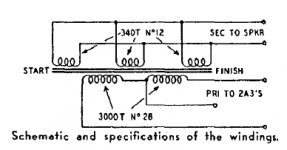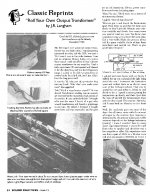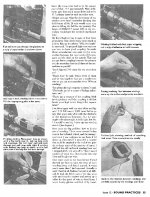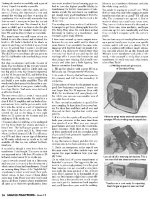hello,
in Sound Practice issue 12 I found an article from
J.R. Langham about rolling your own output, 1948.
There he uses No.26 wire for the primary 6000turns and No.12 wire for the secondary 340turns for a 2A3PP.
I wonder what this means in millimeters.
When I look into the AWG table, 12 is approx. 2millimeter diameter.
But, 2mil wire can not be. Maybe, 1948 they used a other spec?
Thanks and best regards from Germany Armin
in Sound Practice issue 12 I found an article from
J.R. Langham about rolling your own output, 1948.
There he uses No.26 wire for the primary 6000turns and No.12 wire for the secondary 340turns for a 2A3PP.
I wonder what this means in millimeters.
When I look into the AWG table, 12 is approx. 2millimeter diameter.
But, 2mil wire can not be. Maybe, 1948 they used a other spec?
Thanks and best regards from Germany Armin
Last edited:
the core he took from a burned out 300mA power transfomer..
300mA primary?
i do not really know what means a 300mA transformer in 1948, but I think that it is
300mA secondary with maybe 400V for a tube amp or so.
This means it was a 150W type with a core size of approx. 100- 120mm I assume.
And on a core like this, the AWG 12 and AWG26 would not fit.Thatswhy I asked here this question which kind of spec he used..
300mA secondary with maybe 400V for a tube amp or so.
This means it was a 150W type with a core size of approx. 100- 120mm I assume.
And on a core like this, the AWG 12 and AWG26 would not fit.Thatswhy I asked here this question which kind of spec he used..
i do not really know what means a 300mA transformer in 1948, but I think that it is
300mA secondary with maybe 400V for a tube amp or so.
This means it was a 150W type with a core size of approx. 100- 120mm I assume.
And on a core like this, the AWG 12 and AWG26 would not fit.Thatswhy I asked here this question which kind of spec he used..
I must admit I am as baffled as you, all the same a 0.43mm wire isreally over the top if it´s going to have just 60mA flowing. If you want to build the transformer you can use anything AWG33 and up for the primary
here is the sketch:
without knowing the core size, your drawing is useless...
do you have links to the entire aricle?
i do not really know what means a 300mA transformer in 1948, but I think that it is
300mA secondary with maybe 400V for a tube amp or so.
This means it was a 150W type with a core size of approx. 100- 120mm I assume.
And on a core like this, the AWG 12 and AWG26 would not fit.Thatswhy I asked here this question which kind of spec he used..
300mA probably meant the maximum dc current from B+ and push pull indicated...
but it is not good to assume, we must know exact specs...
I think the key thing of that diagram in post #3, certainly the spacing on the drawing implies alternating 3 layers of secondary windings (in parallel ) with perhaps 2 layers of primary ( in series for push pull ). The actual wire size depends on many practical unknowns.
interleaved winding are known for better mutual coupling and lower leakage inductance makes better improvements in HF response.
interleaved winding are known for better mutual coupling and lower leakage inductance makes better improvements in HF response.
what do you want to do?
push pull topology determines core size and power (voltage and current from load line), from those primary windings will be better known. The secondary turns ratio comes from speaker impedance and balanced copper losses under load. IMO thinner laminations are better for OP designs than found reused power transformers. YMMV
push pull topology determines core size and power (voltage and current from load line), from those primary windings will be better known. The secondary turns ratio comes from speaker impedance and balanced copper losses under load. IMO thinner laminations are better for OP designs than found reused power transformers. YMMV
with my Frieseke & Hoepfner FH 88 56 winding machine I want to roll my own 2A3PP transformer.
How to wind 2 wires at same time for a balanced primary like Mr. Langham suggest in his article?
in the article he used single pri. windings on different layers, balance is only as good as the turn counter. Alternating many layers for best coupling.
he seems to think ~ 28 AWG can be used everywhere just parallel more windings. You could use bifilar winding too probably best on the secondary only.
once you have the bobbin dimensions and turns ratio the best wire size becomes clear.
Last edited:
28AWG=0.32mm diameter, this is a good value.
When I build my first SE output, I used 0.28mm for the primary and 0.5mm for the secondary, and from 0.5 five in parrallel.
The only difficulty was, that for the secondary parralleld sections I must ecactly
keep the same turns.The rest was easy, I used a big core, EI120mm with air gap,
the response was 20 hz to 30khz with -3dB.
When I build my first SE output, I used 0.28mm for the primary and 0.5mm for the secondary, and from 0.5 five in parrallel.
The only difficulty was, that for the secondary parralleld sections I must ecactly
keep the same turns.The rest was easy, I used a big core, EI120mm with air gap,
the response was 20 hz to 30khz with -3dB.
- Status
- This old topic is closed. If you want to reopen this topic, contact a moderator using the "Report Post" button.
- Home
- Amplifiers
- Tubes / Valves
- Magnetwire gauge size converted to metric



